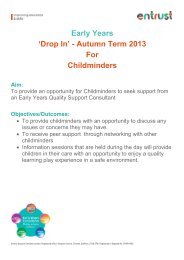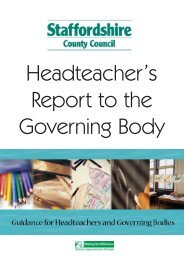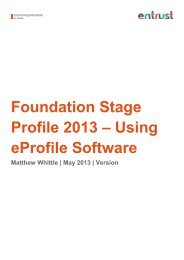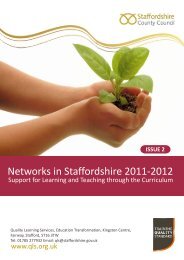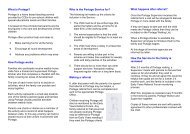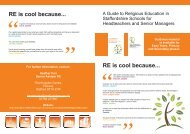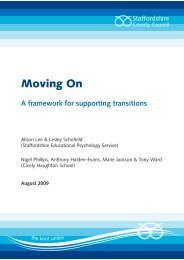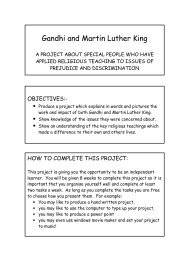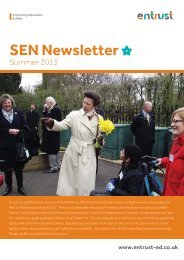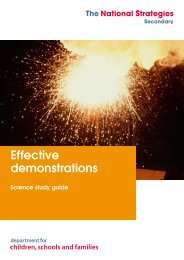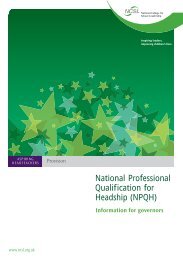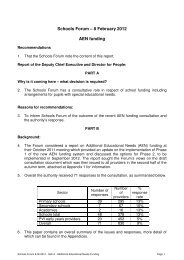Reading skills_save for pdf - Staffordshire Learning Net ...
Reading skills_save for pdf - Staffordshire Learning Net ...
Reading skills_save for pdf - Staffordshire Learning Net ...
You also want an ePaper? Increase the reach of your titles
YUMPU automatically turns print PDFs into web optimized ePapers that Google loves.
INTRODUCTION TO THE STAFFORDSHIRE<br />
READING SKILLS GRIDS<br />
CONTENT OF GRIDS<br />
The content of the grids has been produced with<br />
reference to the following resources:<br />
• National Curriculum level descriptors <strong>for</strong><br />
reading - English AT2 (1999)<br />
• QCA Assessment Focuses <strong>for</strong> reading (2003)<br />
• QCA ‘Building a picture of what children can<br />
do…’ (2004)<br />
• Renewed Primary Framework (2006)<br />
• Assessing Pupils’ Progress in <strong>Reading</strong> - KS3<br />
(2006) & KS2 (2008)<br />
• PNS - Letters & Sounds (2007)<br />
• Early Years Foundation Stage document (2007)<br />
• Revised P scales <strong>for</strong> English, mathematics,<br />
science and ICT (2004)<br />
• Book Bands <strong>for</strong> Guided <strong>Reading</strong> – Bickler,<br />
Baker & Hobsbaum (2003)<br />
ORGANISATION OF THE GRIDS<br />
There are two different grids <strong>for</strong> use with reading<br />
which is below Level 1.<br />
<strong>Reading</strong>: Foundation Stage – FSP Focus<br />
The main grid (page 10) uses statements from the<br />
Early Years Foundation Stage document and is intended<br />
<strong>for</strong> use with Nursery/Reception age children.<br />
<strong>Reading</strong>: Working towards Level 1 - P Levels Focus<br />
A second grid (Appendix – page 16) uses statements<br />
from the ‘P levels’ and is intended <strong>for</strong> use with older<br />
pupils, particularly those with learning difficulties, who<br />
are working significantly below age-related<br />
expectations.<br />
EAL<br />
5<br />
Levels 1-5<br />
Each grid covers one NC level together with the<br />
preceding and following sub-level (e.g. Level 3 Focus<br />
covers the range from 2A- 4C).The different elements<br />
of reading are classified using the QCA Assessment<br />
Focuses <strong>for</strong> reading. The chart below shows the links<br />
between the Assessment Focuses and the reading<br />
strands from the Renewed Framework.<br />
Renewed Framework<br />
reading strands<br />
5. Word recognition:<br />
decoding (reading)<br />
7. Understanding and<br />
interpreting texts<br />
8. Engaging and responding<br />
to texts<br />
Renewed Framework<br />
reading strands<br />
The grids have been structured so that the Assessment<br />
Focuses appear in numerical order. Although the<br />
<strong>Reading</strong> Assessment Focuses are not hierarchical and<br />
they are all important <strong>for</strong> all readers, the guidance<br />
from QCA is that early readers (Levels 1-3) need to<br />
become confident with AF1, AF2 and AF3. For readers<br />
to progress to Level 4 and beyond they need to be<br />
secure with AF3 and to develop the more analytical<br />
and evaluative <strong>skills</strong> associated with AFs 4-7.<br />
For EAL pupils specific assessment criteria can be found in ‘Raising Achievement: The Assessment of pupils<br />
learning English as an additional language’ amended version available shortly from the Ethnic Minority<br />
Achievement Unit. Tel: 01785 278257<br />
AF1<br />
AF1, AF2, AF3, AF4<br />
and AF5<br />
All AFs – especially AF3,<br />
AF6 and AF7



